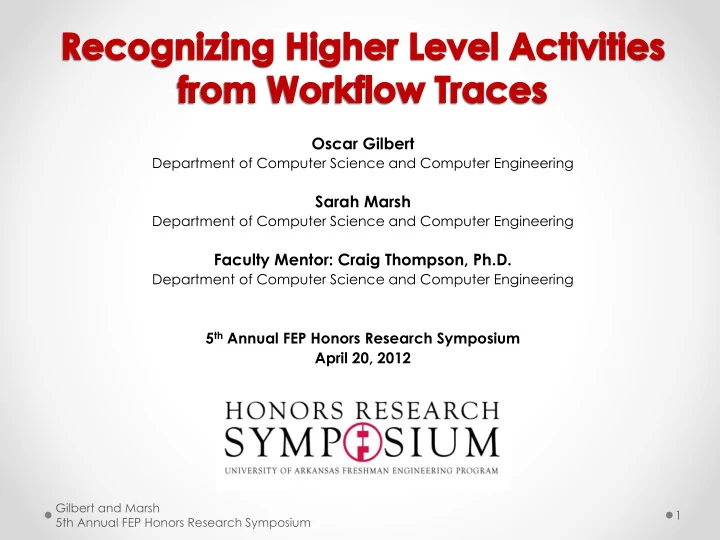

Oscar Gilbert Department of Computer Science and Computer Engineering Sarah Marsh Department of Computer Science and Computer Engineering Faculty Mentor: Craig Thompson, Ph.D. Department of Computer Science and Computer Engineering 5 th Annual FEP Honors Research Symposium April 20, 2012 Gilbert and Marsh 1 5th Annual FEP Honors Research Symposium
Think about your electronics • You probably have…. o A personal computer o A smartphone o A printer o A television o A gaming system o A GPS • These “network devices” can already wirelessly interact with each other. Gilbert and Marsh 2 5th Annual FEP Honors Research Symposium
• WHAT IF… • every real-world object was a network object? • all these objects could interact wirelessly? • This is one of Dr. Craig Thompson’s ideas about pervasive computing in the future. • If this is to come about, computational recognition of human activities will become very important. Gilbert and Marsh 3 5th Annual FEP Honors Research Symposium
• Computers lack the ability to recognize human behavior • This presents an impediment to their use in applications that involve interacting with humans. • If this could be solved, computers would become more helpful to us in our daily lives. Gilbert and Marsh 4 5th Annual FEP Honors Research Symposium
• Gather small amounts of data about human activity. • Write a computer program to interpret the data in such a way that the computer can extrapolate a meaningful workflow from simple activities. Gilbert and Marsh 5 5th Annual FEP Honors Research Symposium
• Our program recognizes workflows (sequences of activities) After prior training, if our program receives input strings: 1. You pick up the trash 2. You go outside 3. You place the trash in the trashcan Then our program will predict possible next step(s) You will move the trash can OR • You go back inside • Gilbert and Marsh 6 5th Annual FEP Honors Research Symposium
• Currently, computers cannot hear or see like humans can. • To sense their world, computers could rely on small amounts of data about the world, also known as sensory traces (because the data streams in from sensors). • These traces will be the foundation upon which our workflows are built. • For our purposes, each sensory reading can be treated as a string (as explained next). Gilbert and Marsh 7 5th Annual FEP Honors Research Symposium
• String = Sequence of characters Ex: “Hello World” or “345sdfds” or “Take the trash can outside” o • Substring = String inside a string Ex: Valid Substrings of “Hello World” = “Hello” / ”o World” / ” Worl ” o • Example of a Function: Function printHelloWorld(){ Print “Hello World” } Gilbert and Marsh 8 5th Annual FEP Honors Research Symposium
• A workflow is a sequence of steps that is organized in time • This concept is significant because our program interprets human behaviors in terms of workflows Gilbert and Marsh 9 5th Annual FEP Honors Research Symposium
• A bad recursive function …. Function printHelloWorld(){ Print “Hello World” printHelloWorld() } • A better recursive function….. Function printHelloWorld(){ Print “Hello World” If (Hello World has been printed ten times) then (Exit Program) Otherwise (printHelloWorld()) } Gilbert and Marsh 10 5th Annual FEP Honors Research Symposium
• Inputs from RFID devices and/or Machine Vision RFID is good at identifying objects o Kinect is good at tracking movement o Kinect + RFID? • An alternative used in our project: Simulated Data Gilbert and Marsh 11 5th Annual FEP Honors Research Symposium
• Represent each activity as a unique string • Finds closest match to current history of activity • Uses match from past history to predict future activity • Deals with branching workflows Gilbert and Marsh 12 5th Annual FEP Honors Research Symposium
• Our program is capable of learning sequences of human behavior and predicting future actions • There are many applications for this technology Gilbert and Marsh 13 5th Annual FEP Honors Research Symposium
• C . Thompson (2004). “Everything is Alive,” Architectural Perspective Column, IEEE Internet Computing , January-February 2004. • Radio Frequency Identification, Accessed November, 2011, URL: http://en.wikipedia.org/wiki/Radio- frequency_identification • A. Eguchi (2013). “Object Recognition Based on Shape and Function: Inspired by Children’s Word Acquisition,” Inquiry J. Undergraduate Research, University of Arkansas. Gilbert and Marsh 14 5th Annual FEP Honors Research Symposium
Recommend
More recommend